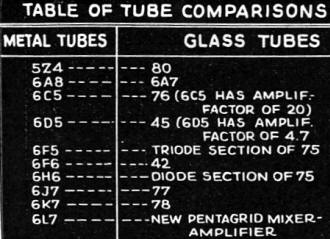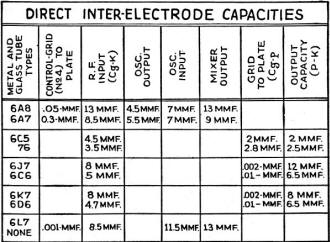Metal vs. Glass Radio Tubes
|
|
Here is a brief synopsis on the main difference between glass and metal vacuum tubes - the metal case tubes generally exhibit higher interelectrode capacitances. It showed up in a 1935 issue of Radio−Craft magazine at the time when metal encased tubes were first appearing. Unless successfully addressed, that limits usefulness in high frequency circuits. Of course in 1935 most radio circuits maxed out in the tens of megahertz, so it was not too much of a problem. One of the major advantageous features of metal tubes is the built-in EMI/RFI shielding both for keeping desirable fields inside the tubes and keeping undesirable fields from entering the tube. Metal vs. Glass Radio Tubes
Albert A. Bombe* Metal tubes wherever they are shown and discussed, raise the question, "How do metal tubes compare in characteristics with our present glass types?" With some basis of fact it might be said that the new metal tubes arrived somewhat ahead of the new need in radio tube design. Consequently the metal tubes follow glass types in general characteristics and differ principally in capacities and the division of certain special-purpose tubes which have two sets of elements in the glass types and are divided into separate metal tubes each containing one set of elements. Several of the new metal tubes almost duplicate in characteristics glass tubes popular in receiver design during the last year - for example: 6J7 - The metal 6J7 closely matches the glass 77. 6K7 - The metal 6K7 is similar to the glass 78. 6A8 - The metal 6A8 has characteristics matching the 6A7. 6F6 - The metal 6F6 matches the glass 42. 5Z4 - The metal 5Z4 rectifier has a rating similar to that applied to the old familiar glass 80. 6H6 and 6F5 - The glass 75, popular since its introduction, has been divided for metal tube production with the diode section appearing in the new metal 6H6, and the triode elements comprising the new metal 6F5. 6C5 - The general-purpose metal triode, type 6C5, is similar in application to the glass 76 but in this case the amplification factor of the metal tube was raised to approximately 20 for improved operation as an oscillator or voltage amplifier. 6D5 - The new metal 6D5 corresponds roughly to the glass 45 in application but, as in the case of the 6C5, the amplification factor is appreciably increased. In addition, the metal 6D5 is a unipotential cathode-type tube with a 6.3 V. heater. The filament-type cathode used in the 45 is not well adapted to the metal tube design. 6L7 - The most noticeable difference between the comparable characteristics of the metal tubes and the glass-tubes in modern use appears in the new metal mixer tube, type 6L7. As explained elsewhere in this issue, this pentagrid tube is not intended for use as a combination first-detector and oscillator but rather as an improved mixer working with a separate beat oscillator, such as the 6C5. The advantages gained with the 6L7 include higher gain and greatly improved isolation of the beat oscillator and signal-grid circuits. In addition, the 6L7 can be used as an R.F. amplifier tube with two control grids in operation. This usage results in improved automatic volume control and much better control-grid cut-off characteristics than have been available with glass types heretofore. Metal tubes have produced new engineering problems both in the design, construction and production of the tubes themselves as well as in the receivers with which they are to function. Many of the constructional changes necessary in receiver design are created by the differences in capacity between similar-type metal and glass tubes. Hence, the comparative capacity data chart - Direct Interelectrode Capacities - shown on this page will be found invaluable as a reference when experimenting with these tubes. *Sales Eng. Dept., Raytheon Production Corp.
Posted July 14, 2023 |
|


